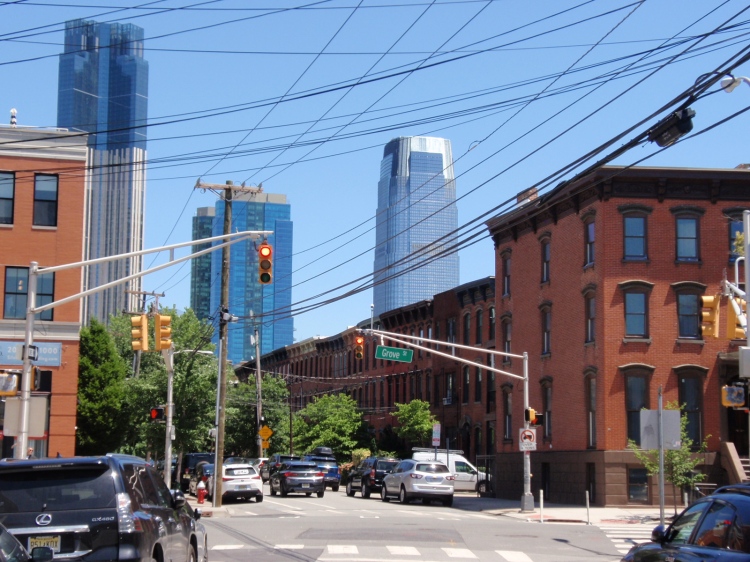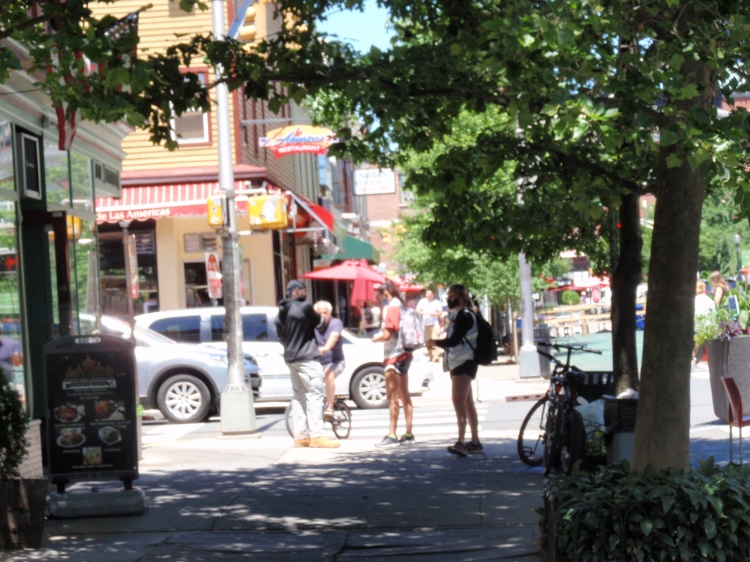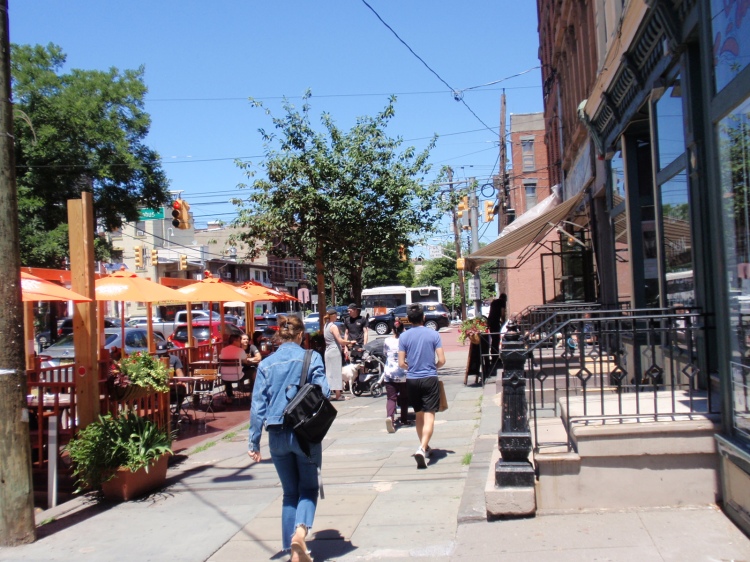Next to the high-rise apartment and office towers downtown by the waterfront is the historic section of the city that goes back to the Dutch settlers. It consists of several small neighborhoods of brownstones, row houses and small to mid-rise apartment buildings. Some are centered around parks and all have a good mix of stores, restaurants, cafes, bars and businesses within walking distance. These features, along with easy access to public transportation to Manhattan have made this a very desirable and affluent area.

The contrast between the built environment of the towers by the waterfront and the historic district next to it is stark reflecting different times, histories and influences on urban planning and design.

The built environments of the towers by the waterfront and the historic district reflect the very different ideas of two of the most famous and influential urban planners of the 20th century: Le Corbusier and Jane Jacobs. The large-scale development of skyscrapers by the waterfront echo Corbusier’s ideas about what makes an ideal city (see blog post Downtown: Le Corbusier) while the historic downtown section represents Jacobs’ ideas.

It was in the 1960’s during a battle to stop a highway from coming through her Greenwich Village neighborhood, that Jacobs began to reflect on the qualities that made her neighborhood worth saving. This led to her classic work on why some neighborhoods thrive while others decline – The Death and Life of Great American Cities. According to Jacobs, the most socially and economically successful neighborhoods have four characteristics that seem to apply to the historic district.
- Variety of buildings: Jacobs believed having a mix of older and newer buildings is ideal. Older buildings may be more affordable for small businesses and allow them to co-exist with larger newer ones with higher rents.

2. Mixed-use buildings: Jacobs argued that residential buildings, mixed with stores, offices, cafes and other enterprises generate a lot of foot traffic at various times of the day making the streets more lively and safe.

3. Concentration of people – there must be a sufficient number of people to populate the sidewalks at various times of the day. These “eyes on the street” make neighborhoods safer and more vibrant.

4. Short blocks: they create more corners which offer alternative paths to streets providing more visual interest and opportunities for chance encounters.

Jacob’s characteristics of an ideal neighborhood apply to the micro-neighborhoods that make up historic downtown. They have a variety of buildings with mixed uses putting stores, businesses, cafes, restaurants, bars and schools within walking distance. These neighborhoods have short blocks creating many corners to turn down streets providing a more interesting environment for residents. They have a sufficient density of people putting more “eyes on the street” for safety and a sense of community.

For Jacobs great cities and neighborhoods are like ecosystems with each component interacting with the others to produce socially and economically vibrant worlds. They evolve over time to meet the changing needs of people. Jacobs sees this as a spontaneous, dynamic process that can be messy and chaotic, but in a good way. They are diverse in terms of buildings, their uses, and their people. They work best with “bottom up” urban planning in which residents decide how their neighborhood changes or remains the same.

Jacobs’ emphasis on the importance of the physical design and layout of neighborhoods as central to their stability and livability has been criticized as a physical fallacy, a form of architectural determinism in which buildings and streets are seen as determining social behavior. Others have argued that she ignored how poverty and racial inequality influence the behavior and quality of life of many urban residents. Still others have defended her work saying she acknowledged the limits of urban design in shaping behavior and that economic and racial inequality would have to be addressed to make cities more livable for all.

Jane Jacobs is remembered mainly for her insightful description and celebration of her ethnically diverse working class Greenwich Village neighborhood with its variety of small mixed-use buildings, on short blocks with people looking out for their neighbors. However, today that neighborhood is a mostly white, affluent enclave. Jersey City’s historic downtown went through a similar transition and today is mostly white and affluent. It was once a more diverse area of working class racial and ethnic groups. However, beginning in the 1970’s, its brownstones, row houses and urban village atmosphere attracted higher income groups. This led to increasing property values displacing many residents. Many of them fought to stay in their homes, winning some battles but losing the war for their neighborhoods.

Left to market forces, working and middle class residents will always be in danger of displacement. It is the responsibility of elected officials to enact policies to ensure new investment does not have this result. As the community based organization P.A.C.O. demonstrates, social activism is key to holding these officials accountable. The battle for equitable redevelopment is being played out across the city today. What will be the outcome this time?
Follow This Blog
Get new content delivered directly to your inbox.
- Gentrification Math & the False Promise of Affordable Housing
- Why is the City Selling Public Property to Luxury Housing Developers?
- Why So Much Luxury Housing in a City Where Most Can’t Afford It?
- Why Do So Many New Apartment Houses Look Alike?
- Signs of Gentrification: House Numbers, Their Color and Design
